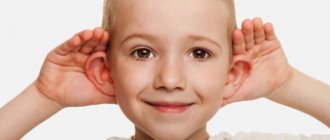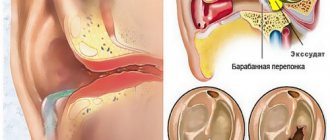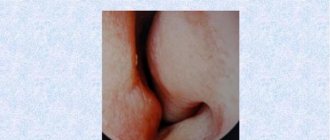gram and audiometry
» Services » What is audiometry.
gram - the result of audiometry, metering is a term denoting a group of hearing research methods.
Depending on the type of sound material used and the technique used, audiometry can be tonal, speech, threshold, suprathreshold, gaming, etc. Typically, the word audiometry refers to pure tone threshold audiometry.
In the future, we will talk about it, since it is the most common and is most often used for selecting and adjusting hearing aids.
Pure-tone threshold audiometry is one of the simplest and most informative methods of hearing research.
The essence of the method is to determine hearing thresholds - sounds of the lowest intensity that a person can hear at different frequencies.
The result of audiometry is an audiogram - a graphic representation of hearing thresholds. The study is performed using a special device - an audiometer.
in the photo - audiometer
Tones are delivered using headphones - through the air and a bone vibrator - through the bone. In the first case, the sound travels the entire path that it normally travels - the ear canal, the eardrum, the chain of auditory ossicles, the cochlea, the auditory nerve - the brain. In a bone study, sound travels through the temporal bone directly into the cochlea.
The study is carried out as follows: the subject is successively given tones of different intensities at different frequencies. If the tone is heard, the subject presses the button (or gives some kind of signal).
The left and right ear, bone and air conduction are measured sequentially. Hearing thresholds are usually measured at frequencies of 125, 250, 500, 1000, 2000, 4000, 6000 and 8000 hertz.
The most significant frequencies are 500, 1000, 2000, 4000 hertz (the so-called fundamental speech frequencies).
gram - result of audiometry
The results obtained are recorded on the audiogram form in the form of curves separately for the left and right ears with air and bone sound conduction. Horizontally, the frequency of the tone is recorded in hertz.
Vertical - tone intensity in decibels relative to average normal hearing thresholds, taken as zero. The thresholds of the right ear are usually indicated by circles, the left - by crosses. The curve of the right ear is usually red, the left is blue.
It should be noted that the values of hearing thresholds increase from top to bottom, i.e. The worse the hearing, the lower the hearing threshold on the audiogram.
in the photo - audiogram
Information provided by the audiogram
First of all, an audiogram allows you to determine the degree of hearing loss. According to the international classification, the degree of hearing loss is determined according to the following scheme:
- 26-40 dB—I degree
- 41-55 dB—II degree
- 56-70 dB—III degree
- 71-90 dB—IV degree
- >90 - deafness
To determine, the average value of air thresholds is taken at frequencies of 500, 1000, 2000 and 4000 Hz
In the first degree, a person usually hears spoken language well and experiences problems only with quiet speech or when communicating in a noisy environment.
In the second degree, spoken speech can be heard from a distance of no more than 2-4 meters, whispering - no further than 1-2 meters. In everyday life, a person with such a hearing impairment often asks again.
If a person has third degree hearing loss, he can clearly hear the words of spoken language only from a distance of no more than 1-2 meters; whispered speech is practically not perceived. The interlocutor, even close to him, has to speak louder than usual. A person with degree four can hear only loud sounds, and communication without the use of sign language or a hearing aid is difficult.
If you are deaf, communication without special aids is almost impossible.
Notwithstanding the above, the degree of hearing loss does not accurately reflect the ability to perceive sounds and speech, since the arithmetic average of hearing thresholds at speech frequencies is used. Therefore, in addition to the degree of hearing loss, the shapes of audiometric curves are also assessed.
They are divided into flat, ascending, descending, steeply descending, trough-shaped or more complex forms that do not have a name. The shape of the curve allows you to evaluate how uneven the hearing loss is at different frequencies and which frequencies are perceived better and which worse.
In most cases of hearing loss, descending audiograms are observed (predominant decrease in high frequencies). Normally, the audiogram is flat and usually does not exceed 15-20 dB.
It is important to compare data from air and bone studies. The presence or absence of a difference in the test results for bone and air allows us to determine the location of the hearing loss. In this regard, conductive disorders (sound conduction suffers), sensorineural (sound perception suffers) and mixed disorders are distinguished.
gram and hearing aids
First of all, the required power of the hearing aid is determined from the audiogram. The hearing aid must have a tuning range with a margin that compensates for the hearing loss of a given patient.
The shape of the audiogram is also important when selecting a hearing aid , since, for example, it sets requirements for the minimum number of channels.
Also, the shape of the audiogram can determine the acoustic configuration, for example, if there are areas of the low-frequency range with intact hearing, open prosthetics can be used (a combination of natural hearing with apparatus amplification).
metry is a key research method for calculating the gain of the device, since existing gain formulas take hearing thresholds and discomfort thresholds as a basis, and modern multi-channel digital devices have the ability to independently adjust the gain for different frequencies.
Many digital hearing aids themselves have the ability to conduct audiometry (for example, a sensorogram in Widex devices).
In this case, hearing thresholds are measured by the hearing aid itself through the earmold (for behind-the-ear aids) or in the housing (for in-ear and intra-canal aids), with which they will subsequently be used.
This feature allows you to more accurately adjust the hearing aid, since the influence of the earmold, housing, ventilation ducts, and anatomical features of the ear canal is minimized.
measurement - basic information for setting up a hearing aid
Despite the great information content of audiometric data, other studies are required to select a hearing aid (otoscopy, speech tests, etc.).
Often, the effectiveness of certain models, even with the same audiometric data, may vary depending on the causes and duration of hearing loss, age, state of the central nervous system and many other individual factors.
It is also impossible not to take into account individual wishes regarding appearance, conditions of use, and financial capabilities. That is why the selection and fitting of hearing aids is carried out by appropriate specialists.
Source: https://www.medaudio.ru/audiogramma-i-audiometriya.htm
Decoding the audiogram
A qualitative examination of the patient determines:
- Damage level
- Degree of hearing impairment
Schedules can be:
- Ascending (for conductive hearing loss)
- Descending (sensorineural hearing loss)
- Horizontal
- Other configurations (depending on pathologies)
The area between the bone conduction graph and the air conduction graph is called the air-bone interval. It reflects what type of hearing loss the doctor is dealing with: sensorineural, conductive or mixed.
A graph ranging from 0 to 25 dB for all frequencies tested indicates that the patient has normal hearing . If the graph goes lower, then this already indicates deviations. The severity of the deviation depends on the degrees of hearing loss, of which there are several in modern medicine: the first degree is defined as mild, the second - moderate, the third and fourth - severe, and deafness - extremely severe.
In medicine, there are different ways to calculate the degree of hearing loss, but the most common is to calculate the arithmetic average of hearing loss at 4 main frequencies. The most important frequencies for speech perception are 500 Hz, 1000 Hz, 2000 Hz and 4000 Hz . So, using a graph, the doctor takes the sum of sound intensity values at 500, 1000, 2000 and 4000 Hz and divides by 4. The resulting arithmetic average values are compared with the international classification of hearing loss and draw conclusions for the right and left ears separately.
metric what is it
The quality of our hearing is affected by age-related changes and various pathological processes. In order to identify hearing impairments, a diagnostic method such as pure-tone audiometry is used.
This procedure allows you to determine hearing acuity for different frequencies of the sound signal. It is performed as prescribed by an ENT doctor and can be carried out in various ways depending on the diagnostic tools used.
Let's try to figure it out: audiometry, what it is.
General information
metry is a diagnostic process in which hearing acuity is examined. It consists of determining a person’s ability to perceive sounds of a certain frequency. The very idea of measuring the degree of a person’s hearing has existed for more than three hundred years.
Initially, such measurements were carried out using an akumeter (a device consisting of a copper ring and a ball) and were called acumetry. Later, striking clocks or tuning forks were used as sound generators. A type of acumetry is the Weber test, carried out using the same tuning forks.
Currently, a special electrical device called an audiometer is used. The result of audiometry is a hearing audiogram. Using an audiogram, an otolaryngologist can judge all kinds of ear diseases, and an audiologist can diagnose various organ defects.
Regular implementation of the procedure provides an opportunity to determine the process of the onset of hearing loss in the patient.
When to use
measurements are carried out in the following cases:
- for various diseases of the middle or inner ear, which can lead to deterioration of hearing;
- in diseases of the nervous system, when the auditory nerves or areas of the brain responsible for hearing are affected;
- in case of ear or head injuries, which may result in hearing impairment;
- at risk of occupational diseases;
- when selecting a hearing aid.
We can say about audiometry that this examination has no contraindications and there is no preparation for it.
Types of audiometry
There are several options for this procedure, each of which has its own characteristics. Let's look at the most common types of audiometry, how they are carried out and what happens as a result.
Speech
This is a classic method that is used without specialized tools. When performing it, the doctor stands at a distance of six meters from the patient and begins to pronounce a special set of words.
The patient’s task is to repeat them. In this case, the doctor pronounces words at normal speech volume or uses a whisper.
The procedure is prescribed to assess the functioning of the hearing organs, or for a screening study.
The method is subjective because the patient can feign deafness and mislead the doctor. Since no quantitative assessments are used, an audiogram is not constructed. It is difficult to determine the difference in the quality of hearing between the left and right ears.
Tonal
The research method is similar to the previous one, however, the patient needs to hear not speech, but sounds of different frequencies. During the procedure, the sound frequency is gradually increased. The patient's task is to press the button at the moment the sound begins to be heard.
The test has proven itself to be excellent for testing hearing in children. Any child undergoes examinations with interest, which are presented to him in the form of a game, and pure-tone audiometry allows him to imagine the doctor not as an “examiner”, but as a gaming partner.
The result of the study is an audiogram graph showing the dependence of the patient’s hearing quality on the frequency of the sound signal. Advantages of the method: allows you to determine hearing impairment at given frequencies.
Using this method, the difference in audibility of the left or right ear is determined, and the threshold values of sound frequencies are determined for sounds of different origins.
The disadvantages of the method include the fact that patients experience discomfort during the procedure. In medicine, this method is more objective than speech, however, it also allows the patient to simulate both good hearing and its absence.
Computer
Today, computer audiometry is the most effective method. It is based on the use of unconditioned reflexes that occur during sound stimulation. The patient's consciousness is not included in the test process; everything happens at the level of reflexes. The patient's reaction to the frequency and volume of sounds is recorded automatically.
In this case, the following reflex manifestations and reactions are used:
- contraction and closing of the eyelids during sharp sounds;
- contraction/dilation of the pupil at sounds of a certain tonality; change in electrical resistance of the skin;
- parameters of the cardiovascular system - changes in pressure, heart rate and pulse;
- inhibition/acceleration of other body functions.
The automated approach eliminates the possibility of simulation during audiometric examination. It can be used for children and patients with mental, speech or coordination problems, that is, for those patients to whom speech or pure-tone audiometry cannot be applied.
The result of pure tone and computer audiometry is a hearing audiogram; we will consider what it is and how to deal with it below.
Decoding audiometry
The audiogram obtained during hearing audiometry consists of two graphs depicted on a plane with two coordinate axes. Sometimes the number of graphs reaches four: they depict air and bone conduction curves for each ear.
The horizontal axis is divided into divisions corresponding to the signal frequency, expressed in hertz (Hz), the vertical axis shows the level of signal intensity and is expressed in decibels (dB).
Decibels show the degree of signal attenuation that the patient's auditory organ is capable of perceiving, expressed as a logarithmic dependence on the maximum signal level.
The peculiarity of the scale in decibels is that the graph axis is located at the top, that is, the signal level grows down. Consequently, the lower its value (that is, the higher the dB), the greater the deviation from the norm is recorded and the patient hears worse.
An audiologist interprets the audiogram. It will determine the hearing threshold and can localize the place where the pathology is observed, thereby indicating the organ that leads to hearing impairment.
Processing the results
Based on the audiogram obtained, the doctor can determine the patient’s degree of sensitivity to sound, that is, find out the level of deafness.
There are international standards by which the doctor assesses the degree of hearing sensitivity. They are presented in the table:
Level of perceptionDegree of hearing loss26 – 40 dBI41 – 55 dBII56 – 70 dBIII71 – 90 dBIVOver 90 dBComplete deafness
In this case, air threshold values, which are defined for frequencies of 500Hz, 1000Hz, 2000Hz and 4000Hz, are taken as control points.
The place of audiometry in the diagnosis of diseases
metry can be used in conjunction with other diagnostic procedures that occur in diseases of the ear and other organs associated with it. For example, diseases and disorders of the vestibular apparatus, which is also located in the area of the inner ear, are determined using vestibulometry supplemented by audiometry.
Deafness in a person can be caused not only by problems in the ears, but also by problems in transmitting signals to the brain through the auditory nerve. Currently, there is a technique based on recording short-latency auditory evoked potentials (SLEP). This identifies most of the possible locations where lesions of the auditory system exist.
The KSVP method is based on recording electrical impulses along the entire length of the auditory pathways from the ear to those areas of the brain in which the auditory center is located. Electrical signal sensors are located on the patient's skin. The method does not require any effort from the patient, since signals are recorded automatically when sound stimulation is applied.
The combined use of various diagnostic techniques can significantly simplify the procedure for making a differential diagnosis. An approach to a patient not from the point of view of diseases of individual organs, but as a whole, often turns out to be much more effective than highly specialized examination and treatment.
A significant part of our knowledge about the world around us and many body functions are associated with good hearing, so expanding the areas of medicine in which audiometry will be involved is a promising direction.
If the audio diagnostic procedure is properly organized, the time spent on it will be minimal, but the information obtained as a result will allow a more qualitative assessment of the patient’s health status.
Conclusion
We looked at what audiometry is, its principle of operation and currently existing methods of implementation. No one is immune from hearing loss. Timely diagnostic procedures for preventive purposes will help prevent many diseases of the hearing organs and preserve it until old age.
Source: https://zen.yandex.ru/media/id/59f9a0235a104fe1e0d6eaf6/5a81eb10f03173b70e52e17f
gram: features of audiometry and interpretation of its results
metric is a term for a group of hearing research methods.
Depending on the type of sound material used and the technique used, audiometry can be tonal, speech, threshold, suprathreshold, gaming, etc. Typically, the word audiometry refers to pure tone threshold audiometry.
In the future, we will talk about it, since it is the most common and is most often used for selecting and adjusting hearing aids.
Pure-tone threshold audiometry is one of the simplest and most informative methods of hearing research.
The essence of the method is to determine hearing thresholds - sounds of the lowest intensity that a person can hear at different frequencies.
The result of audiometry is an audiogram - a graphic representation of hearing thresholds. The study is performed using a special device - an audiometer.
Tones are delivered using headphones - through the air and a bone vibrator - through the bone. In the first case, the sound travels the entire path that it normally travels - the ear canal, the eardrum, the chain of auditory ossicles, the cochlea, the auditory nerve - the brain. In a bone study, sound travels through the temporal bone directly into the cochlea.
The study is carried out as follows: the subject is successively given tones of different intensities at different frequencies. If the tone is heard, the subject presses the button (or gives some kind of signal).
The left and right ear, bone and air conduction are measured sequentially. Hearing thresholds are usually measured at frequencies of 125, 250, 500, 1000, 2000, 4000, 6000 and 8000 hertz.
The most significant frequencies are 500, 1000, 2000, 4000 hertz (the so-called fundamental speech frequencies).
gram - result of audiometry
The results obtained are recorded on the audiogram form in the form of curves separately for the left and right ears with air and bone sound conduction. Horizontally, the frequency of the tone is recorded in hertz.
Vertical - tone intensity in decibels relative to average normal hearing thresholds, taken as zero. The thresholds of the right ear are usually indicated by circles, the left - by crosses. The curve of the right ear is usually red, the left is blue.
It should be noted that the values of hearing thresholds increase from top to bottom, i.e. The worse the hearing, the lower the hearing threshold on the audiogram.
gram and hearing aids
First of all, the required power of the hearing aid is determined from the audiogram. The hearing aid must have a tuning range with a margin that compensates for the hearing loss of a given patient.
The shape of the audiogram is also important when selecting a hearing aid , since, for example, it sets requirements for the minimum number of channels.
Also, the shape of the audiogram can determine the acoustic configuration, for example, if there are areas of the low-frequency range with intact hearing, open prosthetics can be used (a combination of natural hearing with apparatus amplification).
metry is a key research method for calculating the gain of the device, since existing gain formulas take hearing thresholds and discomfort thresholds as a basis, and modern multi-channel digital devices have the ability to independently adjust the gain for different frequencies.
Many digital hearing aids themselves have the ability to conduct audiometry (for example, a sensorogram in Widex devices).
In this case, hearing thresholds are measured by the hearing aid itself through the earmold (for behind-the-ear aids) or in the housing (for in-ear and intra-canal aids), with which they will subsequently be used.
This feature allows you to more accurately adjust the hearing aid, since the influence of the earmold, housing, ventilation ducts, and anatomical features of the ear canal is minimized.
measurement - basic information for setting up a hearing aid
Despite the great information content of audiometric data, other studies are required to select a hearing aid (otoscopy, speech tests, etc.).
Often, the effectiveness of certain models, even with the same audiometric data, may vary depending on the causes and duration of hearing loss, age, state of the central nervous system and many other individual factors.
It is also impossible not to take into account individual wishes regarding appearance, conditions of use, and financial capabilities. That is why the selection and fitting of hearing aids is carried out by appropriate specialists.
Source: https://healthislife.ru/prostuda/audiogramma-osobennosti-provedeniya-audiometrii-i-rasshifrovka-ee-rezultatov.html
Types of audiometry
There are several types of audiometry:
- Speech.
- Tonal.
- Computer.
Each of them has its own characteristics that are worth considering for a better understanding of the principles of the study and the effectiveness of the data obtained. The norm for research is different for each category of people; the doctor checks the data obtained with the required values and draws conclusions about the person’s hearing.
Speech audiometry
The procedure is aimed at determining a person’s sensitivity to sound waves supplied to him.
This method of research is considered the simplest. It must be carried out by pronouncing simple words in a whisper. It is important to consider during the procedure that the result may depend not only on the patient who listens to someone else’s speech, but also on the doctor who pronounces various words. Perhaps the person does not know the word that the doctor pronounces or there is interference from the external environment.
Research shows that whole sentences are much easier to comprehend than individual words. Therefore, the results of this type of audiometry may vary from one doctor to another, and this is not their fault. To conduct research correctly, doctors usually use standard words or numbers so that there are no problems understanding what is said.
Often this method is used not only to determine the quality of hearing, but also to test hearing aids. If the device’s operation is unstable, a person can hear normally from a certain distance, but then problems arise. Therefore, we have to resort to standard verification methods.
Pure-tone audiometry
Pure-tone audiometry shows the degree of sensitivity of a person when sound waves of different frequencies are sent to his hearing organs. The range will be different - from 125 to 8000 Hz. After conducting the study, the doctor must understand within what limits a person’s sensitivity lies, that is, determine the lower and upper limits of perception. The limit level is considered the threshold of discomfort, after which it is very unpleasant for a person to perceive sounds at a frequency.
The examination must be carried out using a device - an audiometer. The patient wears headphones through which signals of different frequencies are supplied. The person’s task is to press the button when he hears any signal, if, of course, he heard it.
The study can be carried out on any age group, but for children an option is offered in the form of a game. With sensorineural hearing loss, the child fails to recognize certain sounds, after which a certain conclusion is drawn.
After performing the tests, an audiogram is obtained. It shows accurate data on how much a person’s hearing differs from accepted norms. You can also see the frequencies at which the patient can hear information.
Computer audiometry
Computer audiometry is considered the most informative method. The patient does not need to participate in the research process. The procedure is fully automated, which is why it is widely popular among infants and newborns.
The study is carried out as follows: sounds of different frequencies are sent to the patient’s ear. With the help of special devices, electrodes, which make it possible to determine vibrations in the brain, it is possible to recognize which sounds a person hears and which ones he cannot recognize. If there is deafness in one of the ears, the audibility data will be zero.
An interesting feature of the procedure is that the patient must sleep during the study. The electrodes and the computer system will independently determine the required data from brain signals and build a complete picture on their basis - an audiogram. The devices are attached to the patient's head and connected to a computer via wires.
Different degrees of hearing loss will distort the result and worsen the data obtained. After examination, the doctor can determine the degree of development of the disease and the level of hearing impairment.
metry: what it is and how it is done – Website about eye diseases and their treatment
metric, what is it? metry is a procedure to determine the presence of hearing acuity. It is used to determine the sensitivity of the hearing aid to different frequencies of sound waves. Such an analysis is performed only by an audiologist (exclusively in a medical institution).
IT IS IMPORTANT TO KNOW! Fortune teller Baba Nina: “There will always be plenty of money if you put it under your pillow...” Read more >>
Types of manipulations
Experts distinguish between computer, speech, tonal, and game audiometry. Computer manipulation is the most informative method for diagnosing hearing.
It is based on various unconditioned reflexes that occur during auditory stimulation. CM is used in patients with any diagnosis and at any age, including newborns.
The entire process is automated. Unconditioned reactions that are being studied:
- blinking reflex - sound stimulation causes the eyelid to contract;
- pupillary-cochlear reflex - irritation by sound provokes pupil dilation;
- audiopalpebral reflex - when a sharp sound occurs, the eyelids close;
- electrical activity of the skin - the electrical conductivity of the skin changes;
- reaction of the cardiovascular system - pressure, heart rate, pulse rate changes;
- In newborns, the sucking reflex slows down.
This audiometry is performed for an accurate analysis of the condition of patients who have suffered a stroke, head injury, with the presence of tumors, cysts, and hematomas. The computer technique is effective if a child’s hearing is suspected to be impaired.
Application of speech technique
Speech audiometry is a procedure that is used in medicine to examine children and adults. During this procedure, the doctor must move away from the patient to a distance of up to 6 m and whisper the words. In this case, the patient is obliged to repeat them. Disadvantages of the method:
- possible simulation of poor hearing;
- inability to track the difference between the audibility of the left and right ears.
Recently, this method has been used to check the normal functioning of the hearing aid. They pronounce a standard universal set of words.
Pure-tone audiometry is similar to a speech examination. The only difference is that instead of words, the patient hears sounds. The frequency of the sound wave gradually increases; the person must press the button at the moment when he hears the sound.
For a child, this happens during play. The range ranges from 25,000 to 8,000Hz. After receiving the results, an audiogram is constructed that shows the frequency range that he hears. At home, you need to clap your hands in front of the baby.
Advantages of this method:
- detection of hearing impairment in a certain frequency;
- difference in sensitivity of the left and right ears.
The disadvantage is the presence of discomfort during the analysis. As with the speech method, you can cheat the results by pressing a button later.
Additional methods
Play audiometry is indicated for children. Since it is impossible to sit small patients in a quiet position for a long time, scientists have developed a game form of hearing testing.
It is carried out to develop motor reflexes that the child uses every day. It is necessary to sit him down, try in every way to lure him with a toy, a picture.
The specialist must stimulate reflex movements, for example, arrange the beads, turn on the lamp, press a bright button.
Screening audiometry is carried out using an audiometer - this is the simplest device that provides a huge opportunity for examining hearing.
Screening provides the power to perform tone diagnostics using air conduction. This is how the hearing range of the patient’s ears is determined. Automatic and mechanical test options are possible.
Additionally, the results of the level of ability of comfortable perception of sound are analyzed.
Cabinet equipment
The examination of the state of the functions of the hearing analyzer is carried out not exclusively with the help of a tuning fork or whisper, but with the use of audiometry to obtain an audiogram. Therefore, in a medical institution there is an obligation to create a specialized room:
- a soundproofed cabin is provided;
- place of work for a doctor;
- the ability to see the patient’s face; for this there must be a special window with glass;
- The subject's place is near the window.
If it is impossible to organize a special office, the procedure can be carried out in the ENT doctor’s office. To do this you need:
- provide excellent sound insulation;
- equip the entrance door with sealing gaskets;
- the presence of an audiometer (special device) of different options (tonal, suprathreshold).
The presence of such devices is mandatory for assessing the perception of sound waves of the subject (at the objective, subjective levels), in order to obtain the results of the unconditioned reflex reaction to sounds, changes in the central nervous structure outside of human activity.
Hearing Test Indicators
The result, which is recorded in an audiogram (special form), has the form of a curve (in two ears separately) obtained during the conduction of air and bone sounds. During the examination, the following data is recorded:
- horizontally - frequency of tones (Hz);
- vertically - the intensity of the tonality (db) in relation to the average normal hearing threshold, taking them as zero;
- the right ear, its threshold, is indicated in the form of a circle;
- left - cross;
- the curve of the right ear is drawn in red;
- left ear - blue;
- the value of the auditory threshold itself increases from top to bottom, that is, the more audibility deteriorates, the lower the threshold limit on the audiogram curve drops;
- with air conduction, the line on the graph is solid;
- bone conduction is represented by a dotted line.
In an absolutely healthy person who has no hearing problems, the audiogram graph looks flat.
Its location is at the limit of 25 - 30 dB - this is the norm. In old age, people lose the ability to perceive high-pitched sounds. Because of this, in both curves there is a descent from the right edge - the first sign of auditory deterioration. Every person should undergo an audiogram to prevent the development of deafness.
When does hearing loss occur?
The causes of hearing impairment in children and adults are associated with acoustic injuries. They occur when the inside of the ear is damaged due to strong sound exposure. Causes:
- long-term exposure to sounds from 6,000 GHz;
- work related to the presence of shots.
The disease begins with the development of hearing loss (unilateral, bilateral). There is a ringing in the ear, a feeling of dizziness, and the ability to hear surrounding sounds is lost. Bleeding from the ear may occur. The eardrum bursts. Only loud speech is perceived in advance.
Vestibular neuroma leads to hearing impairment. The neoplasm consists of Schwann cells. Neuroma can be diagnosed using x-rays of the bones of the temporal region, magnetic resonance therapy and computed tomography of the brain. Treatment directly depends on the size of the tumor.
Otospongiosis is the growth of the labyrinthine capsule in the bone, as a result of which the mobility of the bones in the middle ear is impaired. Symptoms of the disease:
- noise phenomena that are associated with changes in vascular and metabolic processes in the cochlea. It is of low intensity;
- dizziness occurs occasionally, if it occurs, it goes away very quickly;
- ear pain is a consequence of active tissue growth. Bursting pain in the mastoid area. As a result of the attack, there is a decrease in auditory activity.
To make an accurate diagnosis, audiometry is carried out in combination with other examination methods.
Source: https://cliniceye.ru/otit/audiometriya-chto-eto-takoe-i-kak-provoditsya.html
How to decipher an audiogram - a detailed guide from a doctor
Today we are figuring out how to decipher an audiogram. Svetlana Leonidovna Kovalenko, a doctor of the highest qualification category, chief pediatric audiologist-otorhinolaryngologist of Krasnodar, candidate of medical sciences, helps us with this.
Summary
The article turned out to be large and detailed - in order to understand how to decipher an audiogram, you must first become familiar with the basic terms of audiometry and look at examples. If you don’t have time to read for a long time and understand the details, the card below is a summary of the article.
gram - a graph of the patient's auditory sensations. It helps diagnose hearing disorders.
The audiogram has two axes: horizontal - frequency (the number of sound vibrations per second, expressed in hertz) and vertical - sound intensity (relative value, expressed in decibels).
The audiogram shows bone conduction (sound that vibrates to the inner ear through the bones of the skull) and air conduction (sound that reaches the inner ear in the usual way - through the outer and middle ear).
During audiometry, the patient is given a signal of different frequencies and intensities and the magnitude of the minimum sound that the patient hears is marked with dots. Each dot represents the minimum sound intensity at which the patient can hear at a specific frequency. By connecting the dots, we get a graph, or rather, two - one for bone sound conduction, the other for air sound conduction.
The hearing norm is when the graphs lie in the range from 0 to 25 dB. The difference between the bone and air conduction graphs is called the air-bone interval.
If the bone conduction graph is normal, and the air conduction graph is below normal (there is a bone-air interval), this is an indicator of conductive hearing loss.
If the bone conduction graph follows the air conduction graph and both are below the normal range, this indicates sensorineural hearing loss. If the air-bone interval is clearly defined, and both graphs show disturbances, it means mixed hearing loss.
Basic concepts of audiometry
To understand how to decipher an audiogram, let’s first look at some terms and the audiometry technique itself.
Sound has two main physical characteristics: intensity and frequency.
The intensity of sound is determined by the strength of sound pressure, which is highly variable in humans. Therefore, for convenience, it is customary to use relative values, such as decibels (dB) - this is a decimal scale of logarithms.
The frequency of a tone is estimated by the number of sound vibrations per second and is expressed in hertz (Hz). Conventionally, the range of sound frequencies is divided into low - below 500 Hz, medium (speech) 500-4000 Hz and high - 4000 Hz and above.
metry is the measurement of hearing acuity. This technique is subjective and requires feedback from the patient. The examiner (the one who conducts the research) uses an audiometer to give a signal, and the subject (whose hearing is being examined) lets him know whether he hears this sound or not. Most often, he presses a button to do this, less often he raises his hand or nods, and children put toys in a basket.
There are different types of audiometry: tone threshold, suprathreshold and speech.
In practice, the most commonly used is pure tone threshold audiometry, which determines the minimum hearing threshold (the quietest sound a person can hear, measured in decibels (dB)) at various frequencies (usually in the range 125 Hz - 8000 Hz, less often up to 12,500 and even up to 20,000 Hz). These data are noted on a special form.
gram - a graph of the patient's auditory sensations. These sensations can depend both on the person himself, his general condition, blood and intracranial pressure, mood, etc., and on external factors - atmospheric phenomena, noise in the room, distractions, etc.
How to build an audiogram graph
For each ear, air conduction (via headphones) and bone conduction (via a bone vibrator placed behind the ear) are measured separately.
Air conduction is the patient's hearing directly, and bone conduction is the person's hearing, excluding the sound conducting system (outer and middle ear), it is also called the reserve of the cochlea (inner ear).
Bone conduction is caused by the bones of the skull picking up sound vibrations that travel to the inner ear. Thus, if there is an obstruction in the outer and middle ear (any pathological condition), then the sound wave reaches the cochlea thanks to bone conduction.
Audiogram form
On the audiogram form, the right and left ears are most often depicted separately and labeled (most often the right ear is on the left, and the left ear is on the right), as in Figures 2 and 3.
Sometimes both ears are marked on the same form, they are distinguished either by color (the right ear is always red and the left is always blue) or by symbols (the right is a circle or square (0-0-0), and the left is a cross (x-x-x) ).
Air conduction is always marked with a solid line, and bone conduction with a broken line.
Vertically, the hearing level (stimulus intensity) is noted in decibels (dB) in steps of 5 or 10 dB, from top to bottom, starting from −5 or −10, and ending with 100 dB, less often 110 dB, 120 dB.
Frequencies are marked horizontally, from left to right, starting from 125 Hz, then 250 Hz, 500 Hz, 1000 Hz (1 kHz), 2000 Hz (2 kHz), 4000 Hz (4 kHz), 6000 Hz (6 kHz), 8000 Hz (8 kHz), etc., can there may be some variations.
At each frequency, the hearing level is noted in decibels, then the dots are connected to create a graph. The higher the graph, the better the hearing.
How to decipher an audiogram
When examining a patient, it is first necessary to determine the topic (level) of the lesion and the degree of hearing impairment. Properly performed audiometry answers both of these questions.
Hearing pathology can be at the level of sound wave conduction (the outer and middle ear are responsible for this mechanism); such hearing loss is called conductive or conductive; at the level of the inner ear (receptive apparatus of the cochlea), this hearing loss is sensorineural (neurosensory), sometimes there is a combined lesion, such hearing loss is called mixed. Disturbances at the level of the auditory pathways and the cerebral cortex are extremely rare, and then they speak of retrocochlear hearing loss.
Source: https://eu-max.ru/blog/audiogram/
What is an audiogram
This is a chart compiled from the results of tone and computer hearing testing methods. On one of its axis parameters of the frequency of the sound supplied to the patient are marked, on the other - the minimum volume heard by the patient. Decoding the audiogram is necessary when prescribing treatment or selecting and adjusting a hearing aid.
The levels of air and bone conduction on the graph during audiometry are marked by different lines. In the first case, a solid line is used, and in the second, a dotted line. Typically the bone conduction line on the graph is located just above the air sensing line. The distance between them is called the air-bone interval. Interval parameters allow you to determine certain deviations in the perception of sound. For example, an increase in the interval signals the development of otitis media or otosclerosis.
When the functionality of the middle ear is lost, the transmission of sound between the outer and inner ear is disrupted, thereby increasing the thresholds for the perception of sound waves when they are transmitted by air. At the same time, the bone conduction threshold during audiometry has normal values, which is explained by the preservation of the functions of the receptor apparatus of the cochlea and the auditory nerve pathways.
With conductive hearing loss, the audiogram shows an increase in the threshold of hearing low-frequency sounds carried through the air. If the bone perception graph follows the air graph and both are below the normal range, this indicates sensorineural hearing loss. The mixed form of the disease involves an increase in perception thresholds for both the air and bone methods of receiving sound information.









